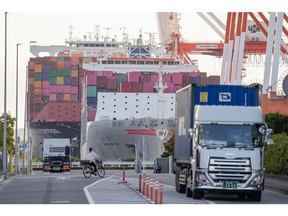
Article content
(Bloomberg) — Halfway through President Donald Trump’s 90-day freeze on his so-called reciprocal tariffs, a persistent gripe from businesses, consumers and governments facing them is severe uncertainty. The next 45 days may not provide much relief from the fog.
THIS CONTENT IS RESERVED FOR SUBSCRIBERS ONLY
Subscribe now to read the latest news in your city and across Canada.
- Exclusive articles from Barbara Shecter, Joe O'Connor, Gabriel Friedman, and others.
- Daily content from Financial Times, the world's leading global business publication.
- Unlimited online access to read articles from Financial Post, National Post and 15 news sites across Canada with one account.
- National Post ePaper, an electronic replica of the print edition to view on any device, share and comment on.
- Daily puzzles, including the New York Times Crossword.
SUBSCRIBE TO UNLOCK MORE ARTICLES
Subscribe now to read the latest news in your city and across Canada.
- Exclusive articles from Barbara Shecter, Joe O'Connor, Gabriel Friedman and others.
- Daily content from Financial Times, the world's leading global business publication.
- Unlimited online access to read articles from Financial Post, National Post and 15 news sites across Canada with one account.
- National Post ePaper, an electronic replica of the print edition to view on any device, share and comment on.
- Daily puzzles, including the New York Times Crossword.
REGISTER / SIGN IN TO UNLOCK MORE ARTICLES
Create an account or sign in to continue with your reading experience.
- Access articles from across Canada with one account.
- Share your thoughts and join the conversation in the comments.
- Enjoy additional articles per month.
- Get email updates from your favourite authors.
THIS ARTICLE IS FREE TO READ REGISTER TO UNLOCK.
Create an account or sign in to continue with your reading experience.
- Access articles from across Canada with one account
- Share your thoughts and join the conversation in the comments
- Enjoy additional articles per month
- Get email updates from your favourite authors
Sign In or Create an Account
or
Article content
Article content
Trump himself has indicated that talks won’t lead to agreements for every nation before the July deadline, saying that 150 countries “want to make a deal” but that many will be assigned their tariff level. Treasury Secretary Scott Bessent said “if they’re not negotiating in good faith, they are going to get a letter saying ‘here is the rate.’”
Article content
Article content
Kelly Ann Shaw, a partner at Akin Gump Strauss Hauer & Feld and former senior Trump trade adviser, said she expects a flurry of deals will come together near the end of the tariff suspension period on July 9.
Article content
By signing up you consent to receive the above newsletter from Postmedia Network Inc.
Article content
“Ninety days is an incredibly ambitious period of time,” she said. “My sense is these are real negotiations for the approximately 18 key trading partners and that, after July 9th, countries left on the cutting room floor will be handed a document with commitments that they can either take or leave in exchange for a new tariff rate.”
Article content
At stake in all the negotiations are more than just trophies on Trump’s trade policy mantel. Central bankers including the Federal Reserve see tariffs — and the potential for higher ones — as restraints on growth, disruptive for financial markets and contributors to inflation as they set interest rates. The longer it takes to strike deals that lower tariffs, the longer the Fed is likely to leave rates unchanged.
Article content
Here’s a rundown of the tariffs facing some of the biggest US trading partners and the efforts made so far to avoid them:
Article content
United Kingdom – 10%
Article content
Article content
Trump hailed the May 8 announcement of a pact with UK Prime Minister Keir Starmer as a “full and comprehensive” agreement despite the fact that it covers a limited number of sectors and leaves the US’s 10% baseline tariff on goods intact. It included carve-outs for Britain’s auto and steel industries, which face 25% US sectoral tariffs that sparked warnings of job losses. Still unclear are when tariff reductions would come into force and key details such as the size of a quota for UK steel exports and the nature of US security requirements regarding ownership of British steel plants.
Article content
China – 34%
Article content
Facing growing pressure from wobbly financial markets and American importers worried about shortages and higher costs, Trump announced May 12 that for a 90-day period, the US would reduce its cumulative 145% tariffs on Chinese goods and leave a 30% levy in place, while China lowered its tax on American imports by the same amount to 10%. The pause until mid-August will give Washington and Beijing time to hold a series of talks using what Bessent calls a “mechanism” to negotiate. Bessent said the “phase one deal” that Trump signed with China in January 2020 served as a template for current aspirations, though “the world has changed, products have changed, product mix has changed — so I think everything is on the table.”

.jpg) 8 hours ago
2
8 hours ago
2
 English (US)
English (US)